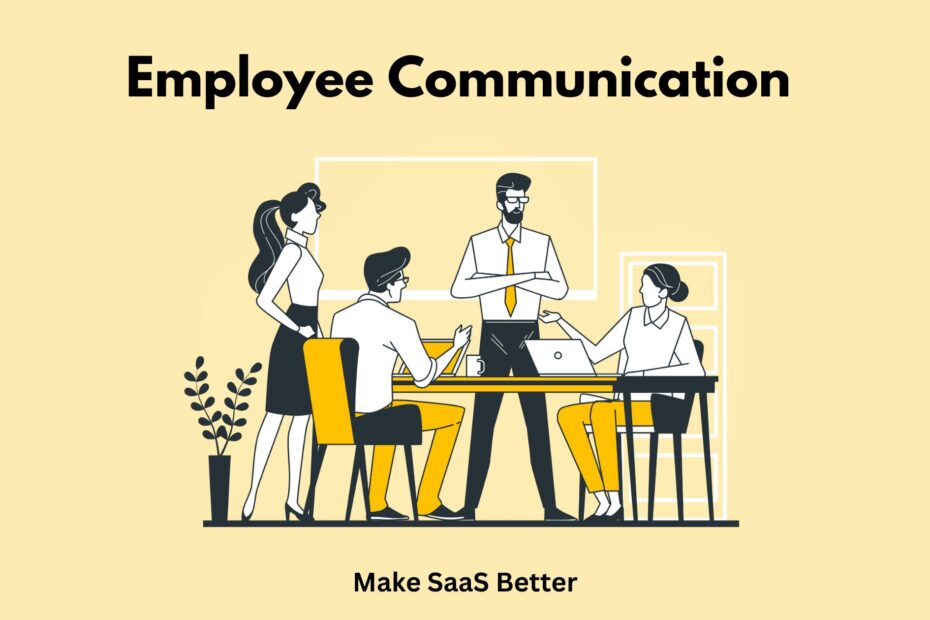Communication is both a personal as well as professional skill and a requirement to survive.
How is a business supposed to run without teams and managers interacting with each other on what needs to be done?
Especially, with remote and hybrid work models becoming increasingly common, effective employee communication is more critical than ever.
Studies show a direct link between strong communication and employee engagement. In fact, highly engaged teams are 21% more profitable.
In this guide, I will walk you through everything you should know about employee communication to keep your workforce informed, motivated, and productive. Let’s get started!
What Is Employee Communication?
Organizations work on the exchange of information and ideas between the employees, management, teams, and all levels of management within a company. This exchange is what we call employee communication.
It can be formal, through meetings, presentations, or company-wide announcements. It can also be informal, through casual conversations, emails, or social media platforms.
The key to effective employee communication is that it’s a two-way street. Information should flow not just from managers down to employees, but also from employees up to management.
Why Is Employee Communication Important?
Listening to employees and understanding where they are coming from is a crucial skill, especially for all leaders. Here’s why good employee communication is crucial –
1. Increases Employee Engagement & Morale
84% of employees believe engagement is the top priority for business success. When employees are engaged they feel valued, and more productive, this is only possible through regular communication.
Communicating regularly with employees shows that you value their opinions and keeps them feeling good about where they work. It also allows for two-way feedback, so employees can share concerns and ideas for improvement, which can boost morale and satisfaction.
2. Better Alignment with Company Goals
When employees understand the company’s goals and how their individual roles contribute, they can work better toward achieving them. In fact, a company with a good communication strategy in place has a 3.5 times higher chance of outperforming competitors.
Hence, clear communication ensures everyone understands the company’s goals, and how their work fits. It keeps everyone aligned and moving in the same direction.
3. Better Collaboration & Enhances Productivity
Good communication and collaboration breaks down silos (those times when different departments don’t talk) and lets people work together more smoothly.
By openly communicating, employees can learn from each other, collaborate on projects more effectively, and solve problems together. Also, teams who communicate effectively are likely to increase their productivity by 25%.
4. Improves Employee Satisfaction and Retention
When companies communicate openly and honestly with employees, it builds trust and makes them feel valued. Employees who feel heard and appreciated are more likely to be happy and stay longer with the company. In fact, 90% of employees are more likely to stay when they feel heard, and their feedback is acted upon.
Not only that, but clear communication can also help reduce stress. When employees know what’s going on and what’s expected of them, they feel less anxious and overwhelmed, while performing better at work.
Now let’s talk about different types of employee communication.
Types Employee Communication
Here are some of the commonly used communication methods –
1. Verbal Communication
Verbal communication is the exchange of information through words. It can happen in various settings, including face-to-face meetings, phone calls, video conferences, team huddles, and even casual conversations by the water cooler.
Verbal communication also helps with immediate feedback, important or in-depth discussions, brainstorming sessions, and negotiations.
2. Nonverbal Communication
This is all about unspoken cues that accompany verbal communication. Body language, facial expressions, and even silence can convey messages. For example, a smile can express warmth and approval, while a frown might indicate disapproval or confusion.
Even the way someone stands or sits can communicate confidence or nervousness. By paying attention to nonverbal cues, we can understand what someone is trying to say, even if their words are ambiguous.
3. Written Communication
This involves using written words to share information. Emails, reports, presentations, and even text messages are all forms of written communication. It’s a versatile tool that can be used for various purposes, from simple instructions to complex technical information.
Written communication allows for careful message crafting and can be easily stored and referred to later. However, it may sometimes lack the richness of nonverbal cues found in face-to-face communication.
4. Visual Communication
Visual communication uses images, charts, graphs, and other visuals to transmit ideas. It can be a powerful tool to simplify complex information, engage audiences, and enhance understanding.
Visuals can break down text-heavy content into easily digestible chunks, making it easier for people to absorb and retain information.
For example, a flow chart can be a clearer way to explain a process than a paragraph of text to explain a complex process. Images can also show better emotions and create a lasting impression.
Best Practices to Improve Employee Communication
1. Create an Internal Communication Strategy
Instead of just sending out messages here and there, come up with a communication plan.
This plan should be like a roadmap that shows what important info employees need to do their jobs well, how often they will get updates, the way/channel of sharing messages, and the best way to reach them.
For example, a software company might make a communication plan to tell employees about a new product update. The plan could include a company-wide video message from the CEO explaining the update, followed by live Q&A sessions for different departments like sales and engineering.
2. Keep the Communication Clear & Straightforward
Avoid long, confusing sentences and words that people don’t use in everyday talking. If you wouldn’t say it to a friend in a casual conversation, it’s probably too complicated for a work email.
Use bullet points, headings, and bold text to make the main ideas clear and easy to find. If it is longer or complex information that needs to be shared then don’t just rely on the written communication methods, also schedule a call to explain everything better to others.
For example, instead of a long email about a new sales target, schedule an all-hands meeting where the points can be made as well as there will be room to clarify doubts and take others’ opinions as well.
3. Use Multiple Communication Channels
Don’t rely on just one communication channel. Think about the best way to deliver the information and the preferences of your team.
Is it a quick announcement that can be shared through a company social media platform or a short video message? Or is it something more complex that needs a more in-depth explanation with Q&A?
You can use:
- Short announcements: Use email, text messages, or company social media posts for quick updates or reminders.
- In-depth explanations: Hold town hall meetings, team meetings, or video presentations for complex information or topics that require discussion.
- Training and How-to guides: Create online tutorials, step-by-step guides, or knowledge-base articles for processes or procedures that employees need to learn.
- Employee recognition: Recognize and celebrate employee achievements through company-wide announcements, social media posts, or even handwritten notes.
4. Encourage Two-Way Communication
Effective communication requires messages to flow both ways. Motivate employees to get involved, and ask questions.
To get them talking more, create a safe space. Let them know it’s okay to share thoughts and concerns. Reward employees who participate in meetings and offer suggestions.
You can also organize employee engagement activities or create mentorship programs to help them feel connected with the team and open up. Leaders should also have an open-door policy to encourage casual chats.
Make sure to answer their concerns promptly, and listen actively when they share ideas.
5. Provide Channels for Feedback and Ideas
Holding QA sessions, and conducting surveys using employee feedback platforms are a great way to get anonymous feedback from employees on different topics like taking their inputs on upcoming projects, problems faced at work, things that can help teams perform better, and so on.
Online forums are also a great way for employees to share thoughts and ideas on company issues, new initiatives, or even just casual topics. This can help build a sense of community and belonging.
It’s important to have a designated person or team to monitor the forums and respond to any questions or concerns raised by employees regularly.
6. Measure the Engagement Levels & Effectiveness
How do you know that your employee communication strategy is working?
By monitoring the engagement levels of your employees, if nothing is changing then you might need to do something to engage your employees better.
The easiest way to assess and find where improvement is required would be to conduct polls and surveys.
You can ask managers, and employees to share their experiences, how they would like to receive communication, do they feel heard, and if the recent communication channels/ways are satisfactory.
For example, Netflix faced the challenge where managers, executives, and board members were spending too much time in communication and decision-making.
As a solution, the business asked board members to only observe meetings and communicate with other leaders through online memos. Doing so helped them save a lot of time, and increase communication effectiveness.
Now let’s discuss some of the best employee communication tools you can add in your employee communication strategy.
Best Employee Communication Tools
1. Instant Messaging Apps
Instant messaging apps like Slack, Microsoft Teams, and Google Chat are communication platforms designed for real-time conversations between individuals and groups.
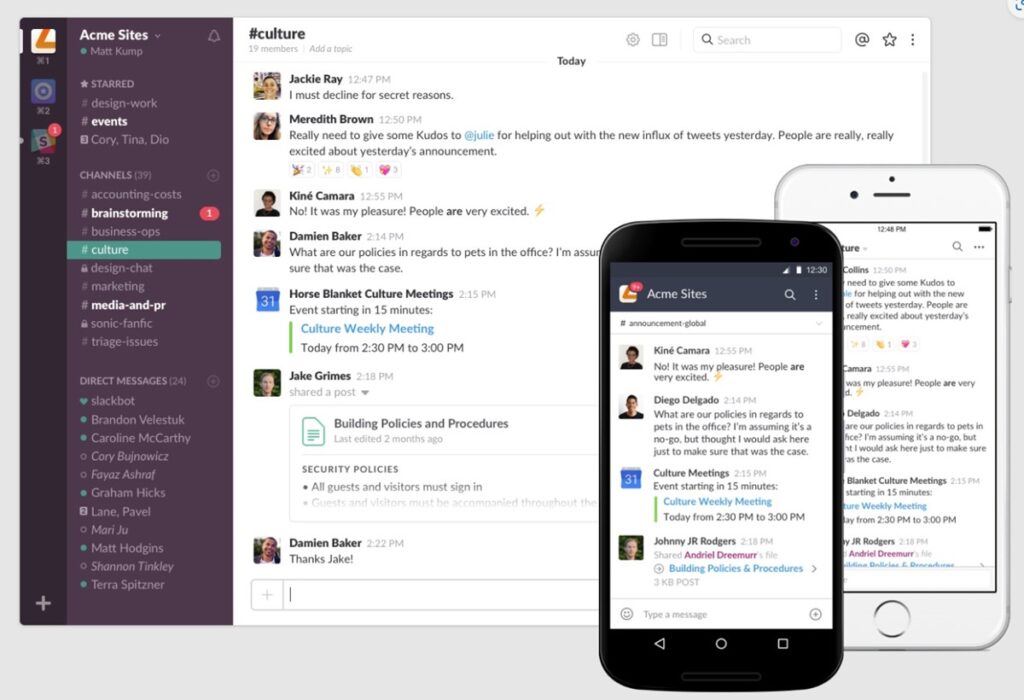
Image – Slack
They are like chatrooms for work, with features specifically aimed towards work communication –
- Quick updates: An instant message to update others and less disruptive than an email.
- File sharing: Easily share documents, images, and other files directly within a chat.
- Threaded conversations: Keep discussions organized with threaded conversations, allowing everyone to follow.
- Group chats: Create dedicated channels for specific teams, projects, or company announcements, keeping everyone informed.
- @mentions: Get someone’s immediate attention by mentioning them within a chat, so that important messages don’t get lost.
- Calendars: This helps everyone keep track of all the meetings and events they are invited to.
- Calling: Teams get voice calls, video calls, screen sharing, screen recording, and more features for smoother one-to-one sessions, and group meetings.
2. Virtual Meeting and Video Conferencing Platforms
Virtual meeting tools like Google Meet and Zoom enable teams to have real-time face-to-face interactions regardless of location.

Image – Zoom
They help with:
- Team meetings and brainstorming sessions: To hold discussions, presentations, and real-time collaboration just like in-person meetings.
- Remote team communication: To Bridge the gap between teams and employees working from different locations or in a remote/hybrid work setting for better remote collaboration.
- Client calls and presentations: for interacting with external parties, clients, and vendors.
- Onboarding and training: to help new hires connect with colleagues and trainers remotely, making the onboarding process smoother.
3. Project Management and Team Collaboration Tools
SaaS tools like Asana, Trello, and Monday.com are specifically designed to help in teamwork and information sharing on projects.
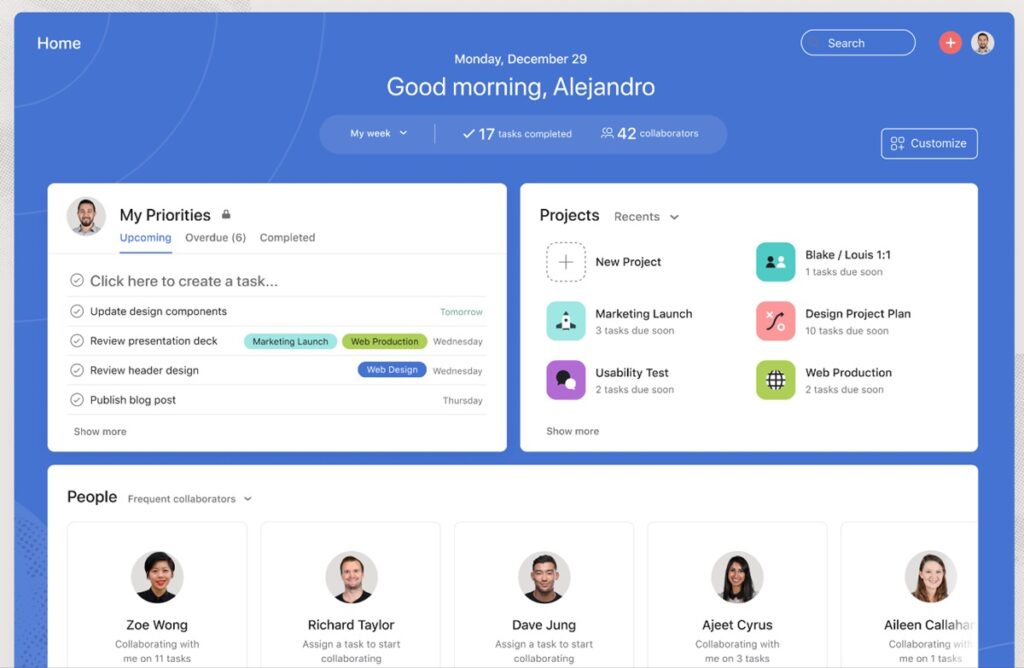
Image – Asana
They offer various features for managing projects, tasks, teams, and resources –
- Task management: Assign, track, and manage individual and team tasks, ensuring everyone is on the same page.
- File sharing and document collaboration: Provide a central location for storing, sharing, and editing documents in real-time, eliminating version control issues.
- Communication channels: Offer built-in chat or messaging features for quick discussions and updates within project teams.
- Workload tracking: Helps keep a tab on the workload of each employee and distribute the work evenly.
- Progress tracking and reporting: Allow teams to visualize progress, identify roadblocks, and adjust plans as needed.
4. Intranets and Social Networks
Intranets and employee social networks together create a central hub for company updates, communication, and community.
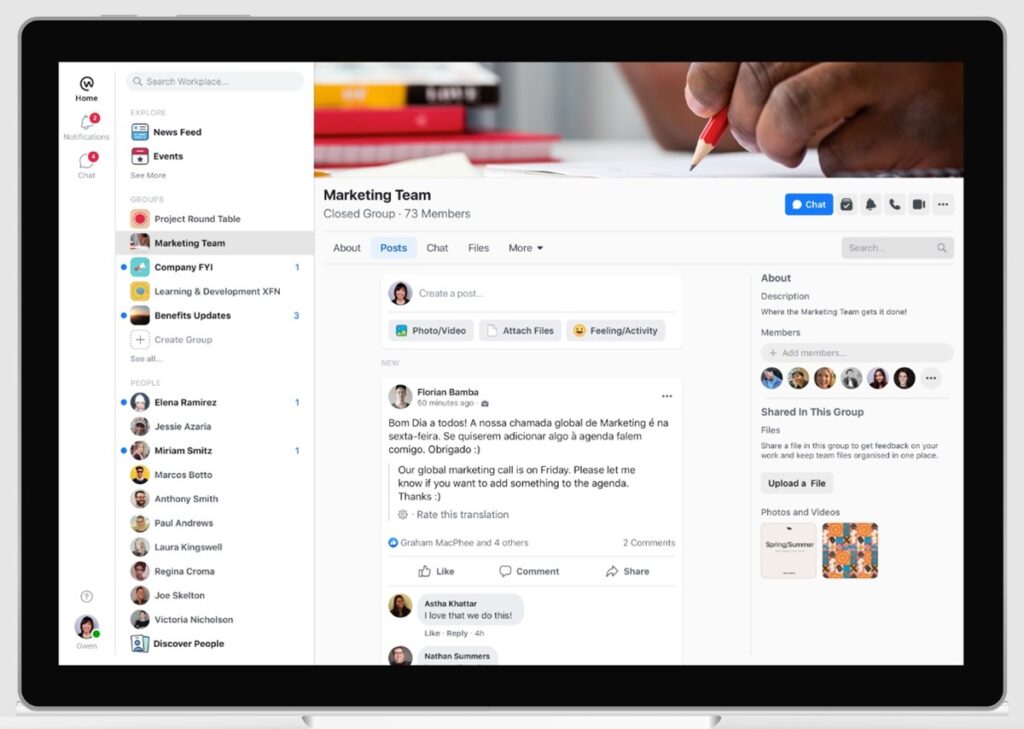
Image – Workplace by Meta
- Intranets like Workplace by Meta, Jostle, and SharePoint provide a repository for company policies, procedures, resources, and announcements, ensuring everyone has easy access to essential information.
- Employee social networks like Yammer, Workplace by Meta, and Floc allow employees to share ideas, connect with colleagues across departments, and build relationships.
These platforms also serve as channels to disseminate company news, achievements, and milestones, keeping everyone informed and engaged. They can also be used to share knowledge and advice from what employees have been learning through their projects.
5. Feedback and Survey Platforms
Feedback and survey platforms like SurveyMonkey, Qualtrics, and Tinypulse are digital tools designed to gather employee insights and opinions in a structured and efficient way.
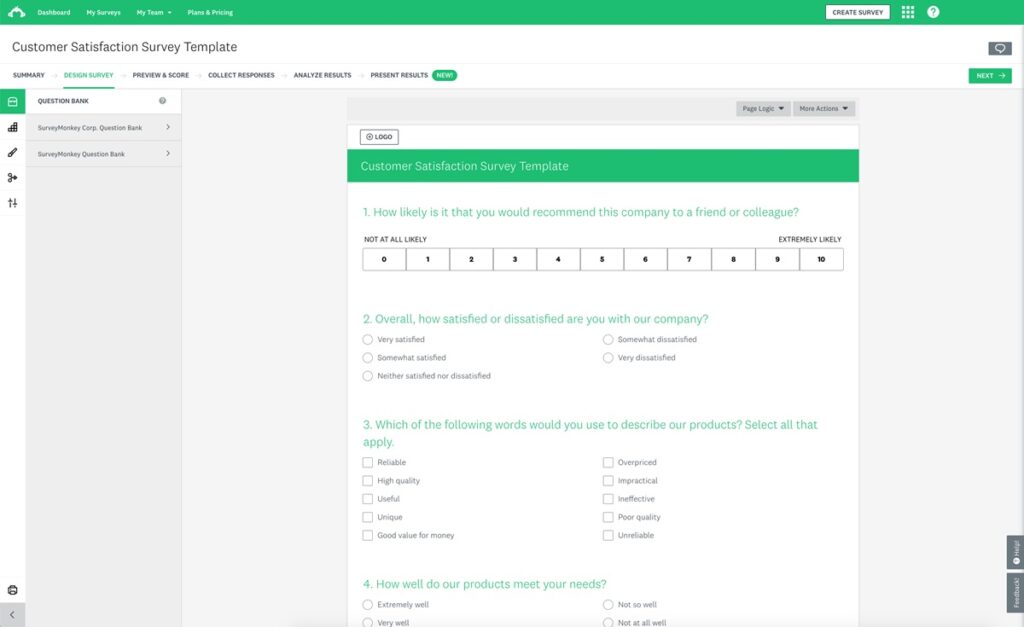
Image – SurveyMonkey
They play a vital role in improving communication, understanding employee sentiment, and fostering a positive company culture. Here’s what they offer –
- Pulse surveys: Regular short surveys that help gauge employee sentiment on various topics, allowing for quick identification of areas for improvement.
- Employee engagement surveys: Capture in-depth feedback on employee satisfaction, work environment, and communication effectiveness.
- Idea boards and suggestion boxes: Encourage employees to share ideas for improvement and participate in conversations.
Excelling in Employee Communication & Business Growth
With more and more people working in remote/hybrid setups, and larger teams, all the mentioned employee communication practices are important to help organizations run smoothly.
Remember, big organizations and businesses can’t function properly without good team coordination which is only possible through transparent and effective communication.
So let’s focus on clear, consistent, and caring communication to build stronger teams, spark new ideas, and succeed together as a team.
